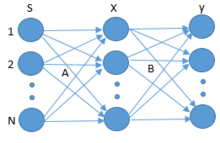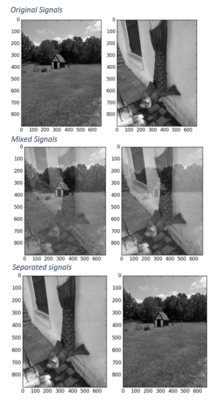This is an old revision of this page, as edited by Arjayay (talk | contribs) at 13:13, 16 February 2019 (Duplicate word removed). The present address (URL) is a permanent link to this revision, which may differ significantly from the current revision.
Revision as of 13:13, 16 February 2019 by Arjayay (talk | contribs) (Duplicate word removed)(diff) ← Previous revision | Latest revision (diff) | Newer revision → (diff)| It has been suggested that Signal separation be merged into this article. (Discuss) Proposed since May 2018. |
Blind signal separation (BSS), also known as blind source separation, is the separation of a set of source signals from a set of mixed signals, without the aid of information (or with very little information) about the source signals or the mixing process. This problem is in general highly underdetermined, but useful solutions can be derived under a surprising variety of conditions. Much of the early literature in this field focuses on the separation of temporal signals such as audio. However, blind signal separation is now routinely performed on multidimensional data, such as images and tensors, which may involve no time dimension whatsoever.
Mathematical representation

The set of individual source signals, , is 'mixed' using a matrix, , to produce a set of 'mixed' signals, , as follows. Usually, is equal to . If , then the system of equations is overdetermined and thus can be unmixed using a conventional linear method. If , the system is underdetermined and a non-linear method must be employed to recover the unmixed signals. The signals themselves can be multidimensional.
The above equation is effectively 'inverted' as follows. Blind source separation separates the set of mixed signals, , through the determination of an 'unmixing' matrix, , to 'recover' an approximation of the original signals, .
Applications
At a cocktail party, there is a group of people talking at the same time. You have multiple microphones picking up mixed signals, but you want to isolate the speech of a single person. BSS can be used to separate the individual sources by using mixed signals. In the presence of noise, dedicated optimization criteria need to be used

Figure 2 shows the basic concept of BSS. The individual source signals are shown as well as the mixed signals which are received signals. BSS is used to separate the mixed signals with only knowing mixed signals and nothing about original signal or how they were mixed. The separated signals are only approximations of the source signals. The separated images, were separated using Python and the Shogun toolbox using Joint Approximation Diagonalization of Eigen-matrices (JADE) algorithm which is based off independent component analysis, ICA. This toolbox method can be used with multi-dimensions but for an easy visual aspect images(2-D) were used.
Brain imaging is another ideal application for BSS. In electroencephalogram (EEG) and magnetoencephalography (MEG), the interference from muscle activity masks the desired signal from brain activity. BSS, however, can be used to separate the two so an accurate representation of brain activity may be achieved.
Other applications:
- Communications
- Stock Prediction
- Seismic Monitoring
- Text Document Analysis
Approaches
Since the chief difficulty of the problem is its underdetermination, methods for blind source separation generally seek to narrow the set of possible solutions in a way that is unlikely to exclude the desired solution. In one approach, exemplified by principal and independent component analysis, one seeks source signals that are minimally correlated or maximally independent in a probabilistic or information-theoretic sense. A second approach, exemplified by nonnegative matrix factorization, is to impose structural constraints on the source signals. These structural constraints may be derived from a generative model of the signal, but are more commonly heuristics justified by good empirical performance. A common theme in the second approach is to impose some kind of low-complexity constraint on the signal, such as sparsity in some basis for the signal space. This approach can be particularly effective if one requires not the whole signal, but merely its most salient features.
Methods
There are different methods of blind signal separation:
- Principal components analysis
- Singular value decomposition
- Independent component analysis
- Dependent component analysis
- Non-negative matrix factorization
- Low-complexity coding and decoding
- Stationary subspace analysis
- Common spatial pattern
See also
References
- P. Comon and C. Jutten (editors). “Handbook of Blind Source Separation, Independent Component Analysis and Applications” Academic Press, ISBN 978-2-296-12827-9
- Jean-Francois Cardoso “Blind Signal Separation: statistical Principles” http://citeseerx.ist.psu.edu/viewdoc/download?doi=10.1.1.462.9738&rep=rep1&type=pdf
- Rui Li, Hongwei Li, and Fasong Wang. “Dependent Component Analysis: Concepts and Main Algorithms” http://www.jcomputers.us/vol5/jcp0504-13.pdf
- ^ Aapo Hyvarinen, Juha Karhunen, and Erkki Oja. “Independent Component Analysis” https://www.cs.helsinki.fi/u/ahyvarin/papers/bookfinal_ICA.pdf pp. 147–148, pp. 410–411, pp. 441–442, p. 448
- P. Comon, Contrasts, Independent Component Analysis, and Blind Deconvolution, "Int. Journal Adapt. Control Sig. Proc.", Wiley, Apr. 2004. HAL link
- Kevin Hughes “Blind Source Separation on Images with Shogun” http://shogun-toolbox.org/static/notebook/current/bss_image.html
- Congedo, Marco; Gouy-Pailler, Cedric; Jutten, Christian (December 2008). "On the blind source separation of human electroencephalogram by approximate joint diagonalization of second order statistics". Clinical Neurophysiology. 119 (12): 2677–2686. arXiv:0812.0494. doi:10.1016/j.clinph.2008.09.007.
- Shlens, Jonathon. "A tutorial on independent component analysis." https://arxiv.org/pdf/1404.2986
External links
- Blind source separation flash presentation
- Removing electroencephalographic artifacts by blind source separation
 , is 'mixed' using a matrix,
, is 'mixed' using a matrix,  , to produce a set of 'mixed' signals,
, to produce a set of 'mixed' signals,  , as follows. Usually,
, as follows. Usually,  is equal to
is equal to  . If
. If  , then the system of equations is overdetermined and thus can be unmixed using a conventional linear method. If
, then the system of equations is overdetermined and thus can be unmixed using a conventional linear method. If  , the system is underdetermined and a non-linear method must be employed to recover the unmixed signals. The signals themselves can be multidimensional.
, the system is underdetermined and a non-linear method must be employed to recover the unmixed signals. The signals themselves can be multidimensional.

 , through the determination of an 'unmixing' matrix,
, through the determination of an 'unmixing' matrix,  , to 'recover' an approximation of the original signals,
, to 'recover' an approximation of the original signals,  .
.
